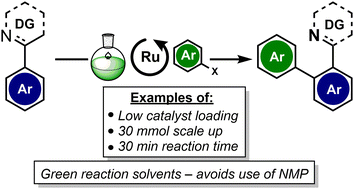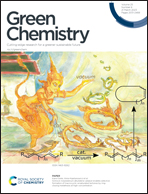Improving the sustainability of the ruthenium-catalysed N-directed C–H arylation of arenes with aryl halides†
Abstract
Direct C–H functionalisation methodologies represent an opportunity to improve the overall ‘green’ credentials of organic coupling reactions, improving atom economy and reducing overall step count. Despite this, these reactions frequently run under reaction conditions that leave room for improved sustainability. Herein, we describe a recent advance in our ruthenium-catalysed C–H arylation methodology that aims to address some of the environmental impacts associated with this procedure, including solvent choice, reaction temperature, reaction time, and loading of the ruthenium catalyst. We believe that our findings demonstrate a reaction with improved environmental credentials and showcase it on a multi-gram scale within an industrial setting.

- This article is part of the themed collections: Celebrating our 2025 Prizewinners and Celebrating the 200th Anniversary of the University of Manchester


 Please wait while we load your content...
Please wait while we load your content...